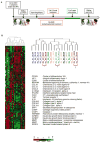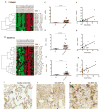Association of Interferon- and transforming growth factor β-regulated genes and macrophage activation with systemic sclerosis-related progressive lung fibrosis
- PMID: 24574232
- PMCID: PMC4439004
- DOI: 10.1002/art.38288
Association of Interferon- and transforming growth factor β-regulated genes and macrophage activation with systemic sclerosis-related progressive lung fibrosis
Abstract
Objective: Systemic sclerosis (SSc)-related interstitial lung disease (ILD) is one of the leading causes of mortality. We undertook this study to analyze the gene expression of lung tissue in a prospective cohort of patients with SSc-related ILD and to compare it with that in control lungs and with 2 prospective clinical parameters in order to understand the molecular pathways implicated in progressive lung disease.
Methods: Lung tissue was obtained by open lung biopsy in 28 consecutive patients with SSc-related ILD and in 4 controls. High-resolution computed tomography (HRCT) and pulmonary function testing (PFT) were performed at baseline and 2-3 years after treatment based on lung histologic classification. Microarray analysis was performed, and the results were correlated with changes in the HRCT score (FibMax) and PFT values. Quantitative polymerase chain reaction (qPCR) and immunohistochemistry were used to confirm differential levels of messenger RNA and protein.
Results: Lung microarray data distinguished patients with SSc-related ILD from healthy controls. In the lungs of patients with SSc-related ILD who had nonspecific interstitial pneumonia (NSIP), expressed genes included macrophage markers, chemokines, collagen, and transforming growth factor β (TGFβ)- and interferon (IFN)-regulated genes. Expression of these genes correlated with progressive lung fibrosis defined by the change in FibMax. Immunohistochemistry confirmed increased markers of collagen (COL1A1), IFN (OAS1 and IFI44), and macrophages (CCL18 and CD163), and the positive correlation with the change in FibMax was confirmed by qPCR in a larger group of SSc patients with NSIP. Several genes correlated with both the change in FibMax (r > 0.4) and the change in % predicted forced vital capacity (r < -0.1), including IFN and macrophage markers, chemokines, and heat-shock proteins.
Conclusion: These results highlight major pathogenic pathways relevant to progressive pulmonary fibrosis in SSc-related ILD: macrophage emigration and activation, and up-regulated expression of TGFβ- and IFN-regulated genes.
Copyright © 2014 by the American College of Rheumatology.
Figures



Comment in
-
Editorial: molecular insights into systemic sclerosis-associated interstitial lung disease.Arthritis Rheumatol. 2014 Mar;66(3):485-7. doi: 10.1002/art.38287. Arthritis Rheumatol. 2014. PMID: 24574206 No abstract available.
References
-
- Ioannidis JP, Vlachoyiannopoulos PG, Haidich AB, Medsger TA, Jr, Lucas M, Michet CJ, et al. Mortality in systemic sclerosis: an international meta-analysis of individual patient data. Am J Med. 2005;118:2–10. - PubMed
-
- Tyndall AJ, Bannert B, Vonk M, Airo P, Cozzi F, Carreira PE, et al. Causes and risk factors for death in systemic sclerosis: a study from the EULAR Scleroderma Trials and Research (EUSTAR) database. Ann Rheum Dis. 2010;69:1809–15. - PubMed
-
- Sampaio-Barros PD, Bortoluzzo AB, Marangoni RG, Rocha LF, Del Rio AP, Samara AM, et al. Survival, causes of death, and prognostic factors in systemic sclerosis: analysis of 947 Brazilian patients. J Rheumatol. 2012;39:1971–8. - PubMed
Publication types
MeSH terms
Substances
Grants and funding
LinkOut - more resources
Full Text Sources
Other Literature Sources
Medical
Molecular Biology Databases
Research Materials
Miscellaneous

